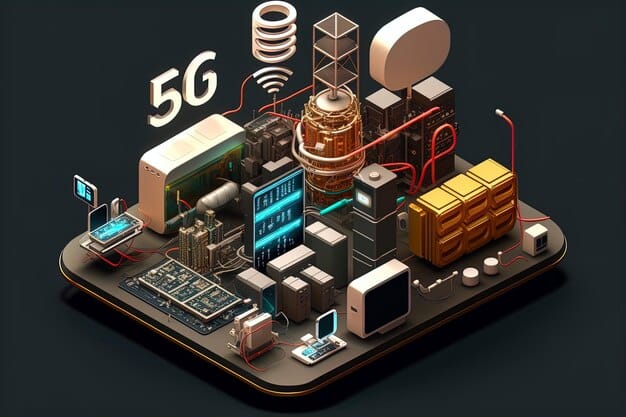5G Network Slicing: Revolutionizing US Industries by 2025

5G network slicing promises to revolutionize US industries by 2025 by enabling customized network capabilities, optimizing performance, and fostering innovation across sectors like healthcare, manufacturing, and transportation through dedicated virtual networks tailored to specific needs.
The advent of 5G network slicing is poised to reshape the landscape of US industries by 2025. This innovative technology allows for the creation of multiple virtual networks with distinct characteristics over a single physical infrastructure, promising unprecedented levels of customization and efficiency.
Understanding 5G Network Slicing
5G network slicing is a game-changing technology that enables mobile operators to create multiple virtual networks on top of a shared physical infrastructure. These virtual networks, or “slices,” can be customized to meet the specific needs of different applications, services, or even entire industries.
This level of customization is a significant departure from traditional network architectures, which typically offer a one-size-fits-all approach. With 5G slicing, operators can allocate dedicated resources, prioritize traffic, and optimize performance for each slice, ensuring that critical applications receive the reliable and high-quality connectivity they require.
Key Components of 5G Network Slicing
Several key components work together to enable 5G network slicing. These include:
- Network Function Virtualization (NFV): NFV allows network functions, such as routing and security, to be virtualized and run on commodity hardware, providing greater flexibility and scalability.
- Software-Defined Networking (SDN): SDN enables centralized control and management of the network, allowing operators to dynamically allocate resources and configure network slices.
- Orchestration: Orchestration platforms automate the creation, deployment, and management of network slices, ensuring that they are provisioned efficiently and meet the required service level agreements (SLAs).
These technologies, combined with the advanced capabilities of 5G, enable operators to deliver a wide range of customized network services, paving the way for innovation and transformation across various industries.
In conclusion, 5G network slicing represents a paradigm shift in network architecture, offering unprecedented levels of customization and flexibility. This technology is poised to play a pivotal role in shaping the future of connectivity and driving innovation across US industries by 2025.

The Impact on Healthcare
The healthcare industry stands to benefit significantly from 5G network slicing. From remote patient monitoring to telemedicine and robotic surgery, 5G slicing can enable a new era of connected healthcare, improving patient outcomes and reducing costs.
By creating dedicated network slices for healthcare applications, providers can ensure reliable, low-latency connectivity for critical services, such as real-time video consultations and remote monitoring of vital signs. This can be particularly beneficial for patients in rural or underserved areas, who may have limited access to traditional healthcare services.
Specific Healthcare Applications
Here are some specific ways in which 5G network slicing can revolutionize healthcare:
- Remote Patient Monitoring: 5G slicing can enable continuous monitoring of patients’ vital signs from the comfort of their homes, allowing healthcare providers to detect potential problems early and intervene proactively.
- Telemedicine: High-quality video consultations enabled by 5G slicing can improve access to specialists and reduce the need for patients to travel long distances for appointments.
- Robotic Surgery: 5G slicing can provide the ultra-reliable, low-latency connectivity required for surgeons to remotely control robotic surgical instruments, expanding access to specialized surgical procedures.
These applications have the potential to transform the way healthcare is delivered, making it more accessible, efficient, and personalized.
In summary, 5G network slicing is poised to revolutionize the healthcare industry by enabling a new era of connected healthcare. By providing reliable, low-latency connectivity for critical services, 5G slicing can improve patient outcomes, reduce costs, and expand access to healthcare services for all.
Transforming the Manufacturing Sector
The manufacturing sector is undergoing a digital transformation, and 5G network slicing is playing a crucial role in this evolution. By enabling wireless connectivity for industrial applications, 5G slicing can improve efficiency, reduce downtime, and enable new levels of automation.
One of the key benefits of 5G slicing for manufacturing is its ability to support massive machine-type communications (mMTC), allowing manufacturers to connect a large number of sensors and devices to the network. This enables real-time monitoring of equipment performance, predictive maintenance, and optimized production processes.
Key Manufacturing Applications
Here are some specific ways in which 5G network slicing can transform the manufacturing sector:
- Predictive Maintenance: 5G slicing can enable the collection and analysis of data from sensors embedded in equipment, allowing manufacturers to predict when maintenance is required and prevent costly downtime.
- Automated Guided Vehicles (AGVs): 5G slicing can provide the reliable, low-latency connectivity required for AGVs to navigate factories and warehouses safely and efficiently.
- Real-Time Monitoring: 5G slicing can enable real-time monitoring of production processes, allowing manufacturers to identify and address potential problems quickly.
These applications have the potential to revolutionize manufacturing, making it more efficient, flexible, and responsive to changing market demands.
In conclusion, 5G network slicing is transforming the manufacturing sector by enabling a new era of connected manufacturing. By providing reliable, low-latency connectivity for industrial applications, 5G slicing can improve efficiency, reduce downtime, and enable new levels of automation.

Revolutionizing Transportation and Logistics
The transportation and logistics industries are also poised to benefit significantly from 5G network slicing. From connected vehicles to smart logistics and autonomous delivery systems, 5G slicing can enable a new era of intelligent transportation.
One of the key applications of 5G slicing in transportation is connected vehicles. By providing reliable, low-latency connectivity, 5G slicing can enable vehicles to communicate with each other and with the surrounding infrastructure, improving safety, efficiency, and traffic flow.
Specific Transportation and Logistics Enhancements
- Connected Vehicles: 5G slicing can enable vehicles to share information about road conditions, traffic congestion, and potential hazards, improving safety and reducing accidents.
- Smart Logistics: 5G slicing can enable real-time tracking of goods and assets, improving efficiency and reducing the risk of loss or theft.
- Autonomous Delivery Systems: 5G slicing can provide the ultra-reliable, low-latency connectivity required for autonomous delivery systems, such as drones and robots, to operate safely and efficiently.
These applications have the potential to transform the way people and goods are transported, making it safer, more efficient, and more sustainable.
In summary, 5G network slicing is revolutionizing the transportation and logistics industries by enabling a new era of intelligent transportation. By providing reliable, low-latency connectivity for connected vehicles, smart logistics, and autonomous delivery systems, 5G slicing can improve safety, efficiency, and sustainability.
The Financial Services Transformation
The financial services industry is rapidly evolving, with digital transformation at its core. 5G network slicing is poised to play a key role in this evolution, enabling secure, reliable, and low-latency connectivity for critical financial applications.
One of the key benefits of 5G slicing for financial services is its ability to provide enhanced security. By creating dedicated network slices for sensitive financial transactions, providers can ensure that data is protected from unauthorized access and cyber threats.
Applications in Finance
Here are some specific ways in which 5G network slicing can transform the financial services industry:
- High-Frequency Trading: 5G slicing can provide the ultra-low latency required for high-frequency trading, enabling firms to execute trades quickly and efficiently.
- Mobile Banking: Secure, low-latency connectivity enabled by 5G slicing can enhance the user experience for mobile banking applications.
- Fraud Detection: Data analysis powered by 5G slicing can enable real-time fraud detection, protecting financial institutions and their customers.
These advancements can lead to more secure, efficient, and customer-centric financial services.
In conclusion, 5G network slicing is set to transform the financial services sector by providing a secure, reliable, and low-latency network. This transformation is essential for financial institutions to remain competitive and meet the evolving needs of their customers.
Challenges and Considerations
While the potential benefits of 5G network slicing are significant, there are also several challenges and considerations that need to be addressed to ensure successful deployment. These include:
One of the key challenges is the complexity of managing multiple network slices. Operators need to develop robust orchestration and management platforms to ensure that slices are provisioned efficiently and meet the required SLAs.
Overcoming Obstacles and Planning for the Future
- Security: Implementing robust security measures is crucial to protect network slices from unauthorized access and cyber threats.
- Interoperability: Ensuring interoperability between different vendors’ equipment and software is essential for seamless deployment of 5G slicing.
- Regulatory Issues: Navigating the regulatory landscape is important to ensure that 5G slicing is deployed in compliance with applicable laws and regulations.
By addressing these challenges and considerations, operators can unlock the full potential of 5G network slicing and drive innovation across US industries.
In conclusion, despite the challenges, the future of 5G network slicing is bright, and overcoming these hurdles is essential for the widespread adoption and success of this transformative technology.
| Key Point | Brief Description |
|---|---|
| 🚀 Customization | Tailored networks for specific industry needs. |
| 🏥 Healthcare | Enhances remote monitoring and telemedicine services. |
| 🏭 Manufacturing | Improves predictive maintenance and automation. |
| 🚚 Logistics | Enables smart tracking and autonomous delivery. |
Frequently Asked Questions
5G network slicing creates multiple virtual networks on a shared physical infrastructure, each tailored for specific needs, ensuring optimized performance, and customization.
It enhances remote patient monitoring and telemedicine, providing reliable, low-latency connectivity for critical healthcare services, especially in underserved areas.
It enables predictive maintenance, automated guided vehicles, and real-time monitoring, leading to optimized processes and reduced downtime in manufacturing facilities.
It supports connected vehicles, smart logistics, and autonomous delivery, increasing safety, efficiency, and sustainability in transportation networks.
Challenges include managing complex networks, ensuring security and interoperability, and navigating regulatory issues for successful deployment and widespread adoption.
Conclusion
In conclusion, 5G network slicing is poised to revolutionize US industries by 2025, offering tailored network capabilities. Despite existing challenges, its widespread adoption promises enhanced services across healthcare, manufacturing, transportation, and finance, ultimately driving innovation and efficiency.





